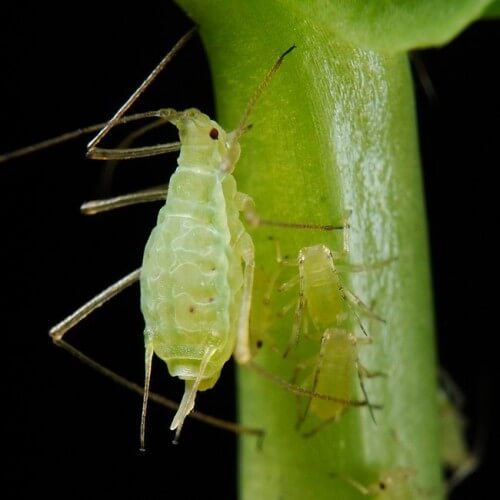Leaf aphids produce pigments with the help of fungal genes
Yonat Ashhar and Noam Levithan Galileo

pea aphids (Acyrthosiphon pisum) on peas. Photo: PLOS Biology cover, February 2010. Shipher Wu (photograph) and Gee-way Lin (aphid provision), National Taiwan University.
the pea aphid, Acyrthosiphon pisum, a small insect that feeds on the sap of plants, may be green or red. This information in itself may not sound particularly fascinating, although for the aphids themselves it is quite important (Moses beetles tend to hunt the red aphids more frequently, while parasitic wasps actually prefer the green ones). What is more interesting is - what gives the different aphids their color?
Nancy Moran (Moran) and Tyler Jarvik (Jarvik) from the University of Arizona published their findings on the subject in the weekly Science. They found that the color of the aphids is due to small molecules called carotenoids which are quite common among bacteria, fungi and plants. Animals get them from their food, and they are important among other things as antioxidants. Many of them have color, and certain animals get their color from the carotenoids they consume - the pink color of flamingos and the color of salmon, for example, originates from the breakdown of beta-carotene, known to us as the substance that turns into vitamin A in our bodies. So, the solution to the mystery should be simple: Different aphids eat different carotenoids, and get different colors.
But some questions remain unsolved. The sap of the plants is an aqueous liquid and the carotenoids can be dissolved in oil, but not in water. If so, how do the aphids get the carotenoids? How can it be that the carotenoids found in aphids are very different from those found in the plants they eat? And why does it seem that the color property can be inherited, when the color red is dominant over green?
The researchers came to the conclusion that aphids themselves have genes that produce carotenoids - a rather revolutionary conclusion, since until now no animal was known to produce these molecules by itself. The aphid's genome, mapped in 2010, allowed researchers to search for these genes. And they did find - some genes of the aphid showed a clear resemblance to the genes of fungi, which create proteins whose function is to produce carotenoids. These genes showed no similarity to genes found in other animals. A great similarity between the sequence of a gene in one organism and the sequence of the gene in another organism usually indicates homology, that is, a common origin of the sequences, and thus an evolutionary relationship. For example, one can find a lot of similarity between many human genes and chimpanzee genes, and even less so between human and mouse genes. But of course no one suggests that the pea aphids evolved from a fungus - their evolutionary origin is from ancient insects and they are evolutionarily closer to us than to fungi. How did genes originating in the fungus end up in the aphid's genome?
The answer lies in a mechanism called "horizontal gene transfer" (genetic engineering, for example). Unlike the vertical transfer of genes between parent and offspring (the usual way we get our genes), horizontal transfer transfers genes from organisms that are not family members and sometimes do not even belong to the same biological species. Such transfer is quite common among bacteria (and is responsible for many of the cases of antibiotic resistance gene transfer, for example), but is rare in animals and plants. The reason for this is that our DNA is well protected in the nucleus of each cell, and the cell has special mechanisms to recognize and break down foreign DNA. However, there are some mechanisms that allow horizontal transmission and some such cases have been observed in animals. The researchers do not know exactly how the horizontal transfer happened in this case, but since all the genes found in the aphids are taken from the same section of the genome, they concluded that this piece of DNA passed as it is from the fungus to the aphid. Since these genes can also be found in peach aphids (Myzus persicae), and even though they may be green or red, the researchers hypothesize that the transfer of the gene cluster occurred in the common ancestor of the aphids. After the transition, a mutation occurred in one of the genes responsible for converting some of the green to red carotenoids. The aphids with this mutation get a green color, while those without the mutation produce red carotenoids that cover this color.
This is a fairly rare example of horizontal transfer, where the genes continued to be active and useful in the new environment in which they found themselves. Now, when more and more genomes of animals, plants and fungi are sequenced and published, we can expect to find more such examples, where the evolution of one biological species is helped by "stealing" genes that evolved in a completely different species.
The original article:
Moran, NA & Jarvik, T. Lateral transfer of genes from fungi underlies carotenoid production in aphids. Science 328, 624-627 (2010). doi: 10.1126/science.1187113
The original article was published in Galileo magazine issue 145, September 2010
